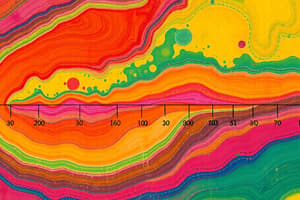Podcast
Questions and Answers
What does the geologic time scale divide up?
What does the geologic time scale divide up?
The history of the earth based on life-forms that have existed during specific times.
Which of the following units is not part of the geologic time scale?
Which of the following units is not part of the geologic time scale?
- Eras
- Days (correct)
- Epochs
- Eons
The principle of superposition states that the layer at the top is the oldest.
The principle of superposition states that the layer at the top is the oldest.
False (B)
Who described how the position of a rock layer could be used to show relative age?
Who described how the position of a rock layer could be used to show relative age?
Which scientist proposed that all rocks came from the ocean environment?
Which scientist proposed that all rocks came from the ocean environment?
Uniformitarianism suggests that the Earth's past can be explained by current geological processes.
Uniformitarianism suggests that the Earth's past can be explained by current geological processes.
What is the geologic time scale?
What is the geologic time scale?
The geologic time scale subdivides time into named units called __________, eras, periods, epochs, and ages.
The geologic time scale subdivides time into named units called __________, eras, periods, epochs, and ages.
Which of the following are principles of geologic time as described by Nicholas Steno? (Select all that apply)
Which of the following are principles of geologic time as described by Nicholas Steno? (Select all that apply)
Abraham Gottlob Werner was known for proposing that all rocks come from volcanic environments.
Abraham Gottlob Werner was known for proposing that all rocks come from volcanic environments.
Who is known for the theory called 'uniformitarianism'?
Who is known for the theory called 'uniformitarianism'?
What is the primary means of establishing a geologic time scale?
What is the primary means of establishing a geologic time scale?
Flashcards are hidden until you start studying
Study Notes
Introduction to Geologic Time Scale
- The geologic time scale divides Earth's history based on the evolution of life forms present during various time periods since the planet's formation.
- The scale is a chronological framework for Earth's history, structured in progressively shorter divisions: eons, eras, periods, epochs, and ages.
- The basis for this organization is stratigraphy, which involves the correlation and classification of rock strata.
- These divisions are known as geochronologic units, with the timing of species' emergence and disappearance from the fossil record defining the boundaries of these intervals.
- The International Chronostratigraphic Chart, maintained by the International Commission on Stratigraphy (ICS), is a widely used reference for understanding the relationships between different geologic time intervals.
Principles behind the Geologic Time Scale
- Danish physician, Nicholas Steno (1638-1687), developed the three main principles for interpreting geologic time:
- Principle of Superposition: The bottommost layer in a sequence of sedimentary rocks is the oldest, having been deposited first.
- Principle of Horizontality: All rock layers were initially deposited horizontally.
- Principle of Original Lateral Continuity: Originally deposited rock layers extend laterally in all directions until they thin out or encounter another rock layer.
- These principles, initially proposed by Steno, were later rediscovered and applied by European scientists.
- Two opposing theories emerged regarding rock formation:
- Neptunists: Led by Abraham Gottlob Werner, they believed all rocks originated from oceanic environments.
- Plutonists: Advocating for volcanic origins for all rocks, they opposed the Neptunist view.
- Scottish physician and geologist, James Hutton (1726-1797), proposed the theory of uniformitarianism, which emphasizes that the present-day processes shaping the Earth are the same as those that occurred in the past. This concept is epitomized by the phrase "the present is the key to the past".
- William Smith, a surveyor involved in mapping a large portion of England, recognized that specific rock units could be identified by their unique assemblages of fossils, leading to the development of biostratigraphy.
Geological Time Scale
- Divides Earth's history based on life forms present at specific times since its creation.
- Represents the ‘calendar’ of Earth’s history.
- Subdivides time into eons, eras, periods, epochs, and ages.
- Based on stratigraphy: correlation and classification of rock strata.
Principles of Geological Time Scale
- Principle of Superposition: Bottom layer deposited first, therefore the oldest.
- Principle of Horizontality: Rock layers initially deposited horizontally.
- Principle of Original Lateral Continuity: Layers extend laterally until thinning or ending at a different rock layer.
Key Figures
- Nicholas Steno: Proposed three main principles for interpreting geologic time (1638-1687).
- Abraham Gottlob Werner: Proposed that all rocks originated from the ocean environment ("Neptunists”).
- James Hutton: Advocated for "uniformitarianism", suggesting that the present helps explain Earth's past.
- William Smith: Identified specific rock units by their unique fossil assemblages.
Studying That Suits You
Use AI to generate personalized quizzes and flashcards to suit your learning preferences.




